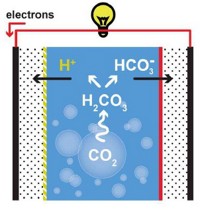Advertisement
Grab your lab coat. Let's get started
Welcome!
Welcome!
Create an account below to get 6 C&EN articles per month, receive newsletters and more - all free.
It seems this is your first time logging in online. Please enter the following information to continue.
As an ACS member you automatically get access to this site. All we need is few more details to create your reading experience.
Not you? Sign in with a different account.
Not you? Sign in with a different account.
ERROR 1
ERROR 1
ERROR 2
ERROR 2
ERROR 2
ERROR 2
ERROR 2
Password and Confirm password must match.
If you have an ACS member number, please enter it here so we can link this account to your membership. (optional)
ERROR 2
ACS values your privacy. By submitting your information, you are gaining access to C&EN and subscribing to our weekly newsletter. We use the information you provide to make your reading experience better, and we will never sell your data to third party members.
Energy
Harvesting Power When Freshwater Meets Salty
Renewable Energy: Researchers boost power output from osmosis method that generates electricity from salinity gradients
by Deirdre Lockwood
November 26, 2013

Although sunlight and wind are two popular sources of renewable energy, some researchers would like to tap saltwater to produce electricity. They have designed methods that harvest the energy released when fresh and saline water mix, such as when a river meets the sea. Now one team has created a prototype device that increases the power output of such methods by an order of magnitude (Environ. Sci. Technol. Lett. 2013, DOI: 10.1021/ez400117d).

One approach to generating power from mixing saline and fresh water is called pressure-retarded osmosis. Two streams of water, one saline and one fresh, meet in a cell divided by a semipermeable membrane. Osmosis drives the freshwater across the membrane to the saltier side, increasing the pressure in the saline solution. The system keeps this salty water pressurized and then releases the pressure to spin a turbine to generate electricity.
The greater the difference in salt concentration between the two water streams, the greater the pressure created and the more power such a system can theoretically produce. For example, a prototype plant by Norwegian energy company Statkraft uses a freshwater-seawater gradient to generate osmotic power of about 1 W/m2 of membrane area. But that power output might not be great enough to be practical on an industrial scale, says Menachem Elimelech of Yale University.
For example, a plant that produces 1 MW could power hundreds of homes. And for that level of output, Elimelech says, “you’d need about a million square meters of membrane.” He and his colleagues wanted to improve the output from the method by using hypersaline solutions, like the waters of the Great Salt Lake or concentrated brine produced by desalination plants.
Unfortunately, the hydraulic pressure created when using such salty solutions—nearly 50 bar—can break the semipermeable membrane. To solve this problem, Elimelech and his team created a prototype cell that protects the membrane under such high pressure.
The cell consists of two rectangular channels, each about 11 cm long and 4 cm wide, with a membrane between them. Freshwater or salty water is pumped along either side of the membrane through narrow 1-mm inlets. This keeps the membrane from folding and breaking. Two pieces of a commercially available woven fabric reinforce the membrane on the freshwater side.
They tested the system with a solution of 3 M NaCl, which is about five times more concentrated than seawater. The system generated power density up to 60 W/m2 without breaking the membrane. “The membrane company didn’t believe our results,” Elimelech says.
Eric M. V. Hoek, an environmental engineering professor at the University of California, Los Angeles, calls the work solid. Based on a model he and his colleagues developed, he estimates that at a full-scale facility the system’s average power density would be close to 3 to 6 W/m2, “which is still pretty amazing,” he says. At those power densities, he calculates that electricity generated by the system would cost about 20 to 30 cents per kWh, approaching the cost of other conventional renewable energy technologies.





Join the conversation
Contact the reporter
Submit a Letter to the Editor for publication
Engage with us on Twitter